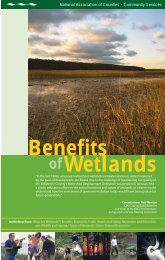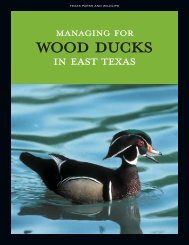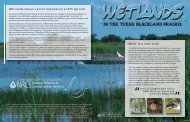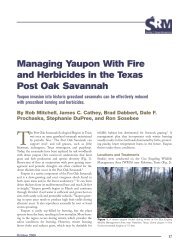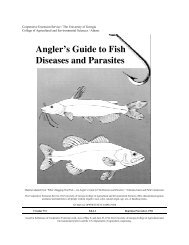Texas Farm Ponds: Stocking, Assessment, and Management ...
Texas Farm Ponds: Stocking, Assessment, and Management ...
Texas Farm Ponds: Stocking, Assessment, and Management ...
Create successful ePaper yourself
Turn your PDF publications into a flip-book with our unique Google optimized e-Paper software.
primary productivity. For this reason, muddy ponds<br />
should not be fertilized. In addition, sight-feeding<br />
fish such as largemouth bass are less successful at<br />
feeding in ponds with severe turbidity.<br />
Factors causing muddy water include watershed<br />
erosion, wave action, large populations of bullhead<br />
or carp, <strong>and</strong> livestock wading into the water.<br />
Correcting these problems by planting riparian<br />
vegetative buffer strips, using rotenone to remove<br />
undesirable fish, <strong>and</strong> fencing off livestock can allow<br />
the material to settle to the bottom of the pond.<br />
Placing a clear jar full of pond water on a shelf for<br />
one week can determine if settling will occur. If,<br />
however, the suspended particles are colloidal clay,<br />
they will not settle out. These tiny particles remain<br />
in suspension because of their microscopic size <strong>and</strong><br />
the electrical charge surrounding their surface. In<br />
this case, a compound must be added to the water to<br />
correct the situation.<br />
Flocculating compounds such as aluminum<br />
sulfate (alum) <strong>and</strong> calcium sulfate (gypsum) work<br />
through a process that allows clay particles to<br />
combine into larger clumps, or “flocs”, that become<br />
large enough to sink out of suspension. Alum is one<br />
of the most effective coagulants, but in lowalkalinity<br />
ponds can reduce pH to levels harmful to<br />
fish. In this situation, hydrated lime must be added<br />
with the alum to offset the reduction in pH. Gypsum<br />
is an effective coagulant in most ponds <strong>and</strong> does not<br />
cause a loss in alkalinity. Gypsum is also priced<br />
more economically, but application rates are greater<br />
when compared to alum. Do not use potting soil<br />
gypsum because this material contains a high<br />
proportion of inert (non-active) ingredients. Use the<br />
purest form of finely ground gypsum available,<br />
whether supplied in bags or bulk. Pond owners<br />
should investigate the economic factors associated<br />
with purchasing, transporting, <strong>and</strong> applying these<br />
materials in addition to their pond’s unique water<br />
chemistry when deciding on a flocculent.<br />
Flocculents should be applied only after the cause<br />
of the turbidity is corrected. Watershed protection<br />
<strong>and</strong> soil conservation practices should receive first<br />
attention. Successful clearing of water following an<br />
application of alum or gypsum can be short-lived if<br />
exposed clay soils within the watershed continue to<br />
erode. Sources of more information on clearing<br />
muddy ponds can be found in the References<br />
section.<br />
Total Alkalinity. <strong>Ponds</strong> located across the state<br />
have different water chemistry, caused by factors<br />
such as soil type, water sources, <strong>and</strong> watershed<br />
characteristics. The water chemistry in a pond<br />
affects primary productivity which determines the<br />
number of fish to stock as well as the pond’s fish<br />
carrying capacity. One characteristic that controls<br />
the ability of a pond to produce fish is alkalinity.<br />
Alkalinity is the measure of buffering capacity, <strong>and</strong><br />
is commonly described as milligrams per liter or<br />
parts per million calcium carbonate (mg/L or ppm<br />
CaCO 3 ). A total alkalinity of at least 20 ppm is<br />
required for good pond productivity. <strong>Ponds</strong> located<br />
within pine-forested watersheds are especially<br />
susceptible to low alkalinity.<br />
In ponds with low alkalinity, pH can vary widely<br />
throughout the course of the day, causing<br />
unnecessary stress on fish populations. In this<br />
situation, it is often difficult to establish a<br />
phytoplankton bloom (see Fertilization section),<br />
which is the base of the pond’s food chain. If you<br />
plan to fertilize, you should have the alkalinity<br />
checked. If alkalinity is less than 20 ppm <strong>and</strong> you<br />
want to fertilize, agricultural lime can be added to<br />
increase alkalinity. Do NOT use hydrated or quick<br />
lime, as rapid pH changes could cause a fish kill.<br />
Agricultural lime is often available in bulk quantities<br />
<strong>and</strong> can be delivered to your site. Common<br />
application rates range from one to four tons per<br />
surface acre. The lime should be applied as<br />
uniformly as possible over the surface of the pond to<br />
ensure coverage. Distributing the lime from a<br />
plywood platform on the front of a boat is a common<br />
application method. Check with local authorities or<br />
review the information found in the accompanying<br />
references to decide if liming is something you need<br />
to consider.<br />
Water Fluctuation. <strong>Ponds</strong> in different parts of<br />
the state experience varied annual rainfall <strong>and</strong><br />
evaporation rates. While East <strong>Texas</strong> farm ponds are<br />
usually full most of the year, South <strong>and</strong> West <strong>Texas</strong><br />
ponds may experience drastic draw-downs during<br />
the summer months. These draw-downs concentrate<br />
fish in small areas <strong>and</strong> can reduce populations<br />
through either predation or oxygen depletion. You<br />
can minimize the impact of such draw-downs by<br />
providing deep water (12 to 16 feet) in part of the<br />
pond, sizing the pond appropriately to the drainage<br />
area of the watershed, <strong>and</strong> constructing a good<br />
quality dam (see Pond Construction Planning<br />
section). Some pond owners combat unwanted<br />
water-level reductions by pumping in groundwater<br />
from a well, but caution should be used as well<br />
water is low in dissolved oxygen. Providing<br />
structure in deeper areas of the pond ensures that<br />
fish habitat will be available regardless of water<br />
7




